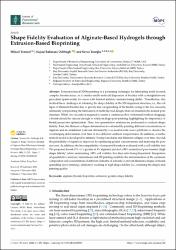| dc.contributor.author | Temirel, Mikail | |
| dc.contributor.author | Dabbagh, Sajjad Rahmani | |
| dc.contributor.author | Tasoglu, Savas | |
| dc.date.accessioned | 2023-03-09T07:39:51Z | |
| dc.date.available | 2023-03-09T07:39:51Z | |
| dc.date.issued | 2022 | en_US |
| dc.identifier.issn | 2079-4983 | |
| dc.identifier.other | WOS:000902567300001 | |
| dc.identifier.uri | https://doi.org/10.3390/jfb13040225 | |
| dc.identifier.uri | https://hdl.handle.net/20.500.12573/1506 | |
| dc.description.abstract | Extrusion-based 3D bioprinting is a promising technique for fabricating multi-layered,
complex biostructures, as it enables multi-material dispersion of bioinks with a straightforward
procedure (particularly for users with limited additive manufacturing skills). Nonetheless, this
method faces challenges in retaining the shape fidelity of the 3D-bioprinted structure, i.e., the collapse of filament (bioink) due to gravity and/or spreading of the bioink owing to the low viscosity,
ultimately complicating the fabrication of multi-layered designs that can maintain the desired pore
structure. While low viscosity is required to ensure a continuous flow of material (without clogging),
a bioink should be viscous enough to retain its shape post-printing, highlighting the importance of
bioink properties optimization. Here, two quantitative analyses are performed to evaluate shape
fidelity. First, the filament collapse deformation is evaluated by printing different concentrations of
alginate and its crosslinker (calcium chloride) by a co-axial nozzle over a platform to observe the
overhanging deformation over time at two different ambient temperatures. In addition, a mathematical model is developed to estimate Young’s modulus and filament collapse over time. Second,
the printability of alginate is improved by optimizing gelatin concentrations and analyzing the pore
size area. In addition, the biocompatibility of proposed bioinks is evaluated with a cell viability test.
The proposed bioink (3% w/v gelatin in 4% alginate) yielded a 98% normalized pore number (high
shape fidelity) while maintaining >90% cell viability five days after being bioprinted. Integration
of quantitative analysis/simulations and 3D printing facilitate the determination of the optimum
composition and concentration of different elements of a bioink to prevent filament collapse or bioink
spreading (post-printing), ultimately resulting in high shape fidelity (i.e., retaining the shape) and
printing quality | en_US |
| dc.description.sponsorship | S.T. acknowledges Tubitak 2232 International Fellowship for Outstanding Researchers
Award (118C391), Alexander von Humboldt Research Fellowship for Experienced Researchers, Marie
Skłodowska-Curie Individual Fellowship (101003361), and Royal Academy Newton-Katip Çelebi
Transforming Systems Through Partnership award (120N019) for financial support of this research.
This work was partially supported by Science Academy’s Young Scientist Awards Program (BAGEP),
Outstanding Young Scientists Awards (GEB˙IP), and Bilim Kahramanlari Dernegi The Young Scientist
Award. | en_US |
| dc.language.iso | eng | en_US |
| dc.publisher | MDPI | en_US |
| dc.relation.isversionof | 10.3390/jfb13040225 | en_US |
| dc.rights | info:eu-repo/semantics/openAccess | en_US |
| dc.subject | alginate | en_US |
| dc.subject | bioink | en_US |
| dc.subject | bioprinter | en_US |
| dc.subject | extrusion | en_US |
| dc.subject | gelatin | en_US |
| dc.subject | shape fidelity | en_US |
| dc.title | Shape Fidelity Evaluation of Alginate-Based Hydrogels through Extrusion-Based Bioprinting | en_US |
| dc.type | article | en_US |
| dc.contributor.department | AGÜ, Mühendislik Fakültesi, Makine Mühendisliği Bölümü | en_US |
| dc.contributor.authorID | 0000-0002-8199-0100 | en_US |
| dc.contributor.institutionauthor | Temirel, Mikail | |
| dc.identifier.volume | 13 | en_US |
| dc.identifier.issue | 4 | en_US |
| dc.identifier.startpage | 1 | en_US |
| dc.identifier.endpage | 16 | en_US |
| dc.relation.journal | JOURNAL OF FUNCTIONAL BIOMATERIALS | en_US |
| dc.relation.tubitak | 118C391 | |
| dc.relation.publicationcategory | Makale - Uluslararası Hakemli Dergi - Kurum Öğretim Elemanı | en_US |


















